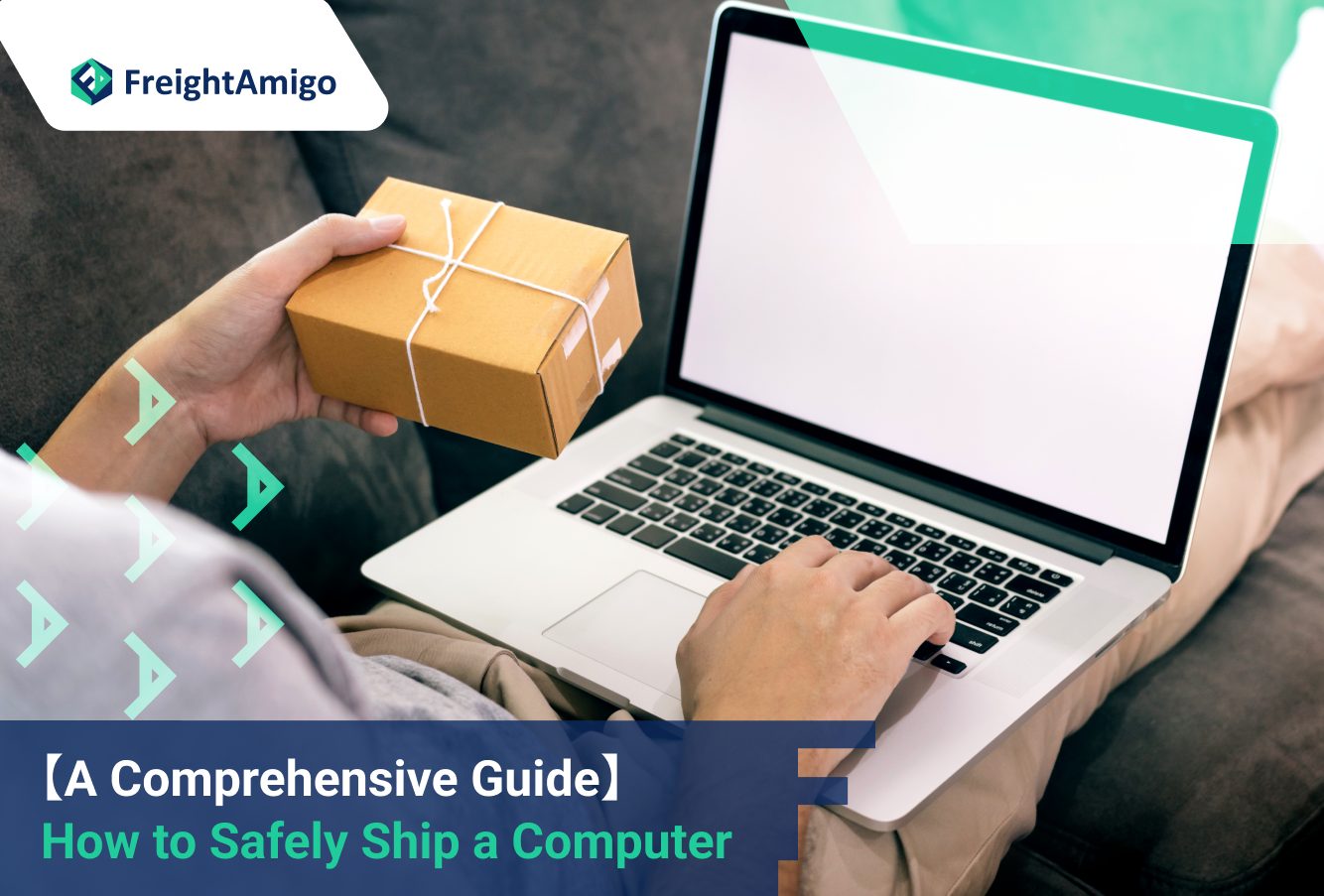16th January, 2024 Caspian Ng – Marketing Analyst at FreightAmigo
Shipping electronics, such as a computer can be a daunting task. Computers are not only expensive but also fragile, and you want to ensure they arrive at their destination intact. In this comprehensive guide, we will walk you through the process of safely shipping a computer. From selecting the right shipping box to packing the computer securely and choosing the best shipping options, we’ve got you covered. So let’s dive in and learn everything there is to know about how to ship a computer.
Want to compare the best Express, Air Freight, Sea Freight, Rail Freight & Trucking rates so as to have better control on cost?
Selecting the Right Shipping Box
The first step in shipping a computer is selecting the right shipping box. Proper packaging is crucial to ensure the safety of your computer during transit. If you are shipping a new laptop, using the original box it came in from the manufacturer is your best option. These boxes are designed to provide a reasonable level of protection for your device.
However, if you are shipping a desktop computer or no longer have the original box, you can purchase computer shipping boxes in various sizes. These boxes are specifically designed to accommodate the size and shape of computers. Alternatively, you can create your own box by choosing an outer box that is about six inches wider in all dimensions than the internal container. This allows for additional cushioning and protection.
How to Pack a Computer
Once you have the right shipping box, the next step is to pack the computer securely. Proper packing is essential to minimize the risk of damage during transit. Here are some key steps to follow when packing a computer:
Step 1: Prepare the Computer
Before packing the computer, make sure it is clean and free from any moisture. Dust off the device and ensure it is completely powered down. It is also recommended to remove any external devices such as USB drives or CDs.
Step 2: Protect the Components
To protect the computer components, start by wrapping the shell of the machine with plastic or bubble wrap. This provides an additional layer of protection against scratches and minor impacts. For laptops, consider placing a thin layer of bubble wrap or foam between the keyboard and screen to protect the keys and screen while the laptop is closed.
Step 3: Secure the Cables and Accessories
Separately wrap any cables, plug adaptors, and other accessories in bubble wrap and secure them with cable ties. This prevents them from getting tangled or damaged during transit. It is important to keep all the accessories together to avoid any missing parts upon arrival.
Step 4: Place the Computer in the Box
Carefully place the wrapped computer in the shipping box. If there is any extra space, fill it with additional packaging material such as foam inserts or bubble wrap to ensure a snug fit. This prevents the computer from shifting during transit and reduces the risk of damage.
Step 5: Seal the Box
Once the computer is securely packed in the box, seal the box tightly with packing tape. It is recommended to use multiple layers of tape to ensure the box remains closed during transit. This also provides an extra layer of security against tampering.
Choosing the Best Shipping Options
When it comes to shipping electronics, such as a computer, choosing the right shipping options is crucial. Consider the following factors when selecting the best shipping method:
Domestic Shipping
For domestic shipments within the United States, popular shipping carriers like UPS offer a range of options. You can choose from same-day, one- to five-day delivery options. UPS Express Critical and UPS Ground are reliable choices for domestic shipments. If you require faster delivery, UPS Next Day Air and UPS 2nd Day Air are available.
International Shipping
If you need to ship a computer internationally, UPS offers a wide range of international shipping services. These services include the best available flight, one- to five-day delivery, and day-definite delivery choices. UPS has extensive global coverage, ensuring that your computer reaches its destination in a timely manner.
To determine the cost and estimated delivery time for shipping your computer, you can use the UPS Calculate Time & Cost tool. This tool provides you with an estimate based on the dimensions, weight, and destination of your package.
Protecting Your Computer During Air Travel
If you are shipping a computer by air, it is important to take additional precautions to protect the device against overheating and potential damage. Air travel can expose computers to heat and static electricity risks, particularly for laptops with lithium-ion batteries. Here are some tips to protect your computer during air travel:
Tip 1: Ensure Complete Power Down
Before shipping the computer, make sure it is completely powered down. This includes powering off the device and, if possible, removing the battery. This helps prevent accidental activation during transit.
Tip 2: Follow Battery Shipping Regulations
When shipping computers with lithium-ion batteries, it is important to comply with the shipping regulations. Familiarize yourself with the regulations for shipping batteries within the United States or to your destination country. Ensure that any required labels or notices are securely attached to the outside of the shipping box.
Tip 3: Consider UPS Delivery Intercept
UPS offers a service called UPS Delivery Intercept, which allows you to maintain control of your package as it moves through the UPS network. With UPS Delivery Intercept, you can request actions such as return to sender, delivery to another address, reschedule delivery, or will-call. This service provides flexibility in managing your shipping needs and ensures the safety of your computer.
Shipping with USPS
In addition to UPS, you can also consider shipping your computer through the U.S. Postal Service (USPS). USPS offers a variety of shipping options, including Priority Mail Express, Priority Mail, and USPS Retail Ground. These services provide reliable and cost-effective solutions for shipping computers domestically and internationally.
When shipping with USPS, it is important to ensure that your computer is properly packaged to withstand shipping stresses. USPS does not sell package carrier supplies, so you will need to purchase packaging materials such as envelopes, boxes, bubble cushioning, packaging peanuts, and tape from other sources.
To determine the shipping rates for your packages, you can use the USPS postage calculator. This tool helps you find the best shipping rates based on the size, weight, and destination of your package.
Comparing UPS and USPS
When comparing UPS and USPS for shipping a computer, there are several factors to consider. While UPS may offer faster delivery options and greater flexibility, USPS provides cost-effective shipping solutions, especially for lighter packages. The choice between UPS and USPS ultimately depends on your specific needs and priorities.
It is worth noting that prices for packaging supplies and services may vary between UPS and USPS locations. Contact your local UPS or USPS location for pricing information specific to your area.
Professional Packaging Services
If you prefer to leave the packaging to the experts, both UPS and USPS offer professional packaging services. At UPS, their locations are staffed with packing professionals who can securely pack your computer for shipment. Similarly, USPS offers packing services at select locations.
By opting for professional packaging services, you can have peace of mind knowing that your computer will be properly packed and protected during transit. The packaging experts at UPS and USPS are trained to uphold quality packaging standards to ensure the safe arrival of your computer.
Insurance and Tracking
When shipping a computer, it is important to consider insurance and tracking options. Both UPS and USPS offer declared value programs that allow you to insure your shipment. This provides financial protection in case of loss or damage during transit.
To track your shipment, both UPS and USPS provide online tracking features. You can enter your tracking number on their respective websites to get real-time updates on the location and status of your package. In case you encounter any issues with tracking, you can contact the carrier directly for assistance.
Handling Damaged Shipments
In the unfortunate event that your shipment arrives damaged, it is important to take immediate action. If you are the sender, notify the UPS or USPS location where you shipped your item(s) to report the damage and initiate the claim process. They will guide you through the necessary steps to file a claim.
If you are the recipient, contact the sender of the shipment and inform them about the damage. The sender will need to report the damaged shipment to the UPS or USPS location where the item(s) were shipped from. It is advisable to save all packaging materials as they may be required for the claim process.
Shipping Tips and Best Practices
Here are some additional tips and best practices to ensure a smooth shipping experience for your computer:
- Always use proper packaging materials such as bubble wrap, packing peanuts, and sturdy boxes.
- Double-check the power status of the computer and ensure it is completely powered down.
- Label the package clearly with the recipient’s address and contact information.
- Consider adding “Fragile” labels or “This Way Up” stickers to indicate the delicate nature of the contents.
- Keep a record of your tracking number and shipping details for reference.
Customer Convenience and Global Growth
Both UPS and USPS are committed to providing excellent customer service and convenience. With a wide range of shipping options, professional packaging services, insurance coverage, and tracking capabilities, they strive to meet the diverse needs of customers shipping computers.
As technology continues to advance, the shipping industry is evolving to accommodate the growing demands of global connectivity. UPS and USPS are at the forefront of this transformation, continuously improving their services to enhance the customer experience and facilitate global growth.
Conclusion
Shipping a computer requires careful planning and attention to detail. By following the steps outlined in this comprehensive guide, you can ensure that your computer arrives safely and intact at its destination. Whether you choose UPS or USPS, both carriers offer reliable shipping options and professional packaging services to meet your needs. Remember to consider insurance and tracking options for added peace of mind. With the right preparations and precautions, shipping a computer can be a smooth and stress-free process.
There are different options for cargo transportation. If you want to choose the most convenient and suitable solution, it is best to have the full support of logistics experts! If you are planning to ship goods overseas, please go to the FreightAmigo page for inquiries.
===
Read More:
How to ship electronics: A Comprehensive Guide
Best Practices and Tips for a Secure Delivery
===
If you have any inquiries on logistics/supply chain, feel free to contact FreightAmigo now:
Chat with us online OR Hotline : +852 28121686 OR WhatsApp: +852 27467829









































